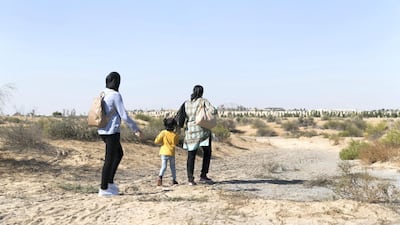The transformation of a former waste dump into the Dubai Safari has turned Al Warqa into an environment conducive for different bird species to thrive.
The formation of the park last year created a new habitat for local and migratory birds in a city where natural habitats are strained, according to a study by Dr Mohammed Khan, the principal wildlife specialist at the site.
"At a time when much of the natural habitat in the area of greater Dubai is under pressure, this study provides evidence of the ability of bird species to make use of areas formerly of little ecological value which are developed with a view to creating new habitats," Dr Khan said.
In the late 1970s, Dubai Municipality used the site as an area for solid waste disposal. Less than 20 years later, waste disposal ceased after the dump covered an area of around four square kilometres and had risen to a height of around 30 metres above the surrounding land surface.
The dump remained undisturbed until May 2012, when Sheikh Mohammed bin Rashid, Vice President and Ruler of Dubai, gave instructions that the site and adjacent areas be handed over to the municipality's Project Department for the development of Dubai Safari.
_____________
Read more:
WATCH: A first walk around Dubai Safari
First look inside the walls of Dh1 billion Dubai Safari
Two wild bird species spotted in UAE for first time in 2017
_____________
It was then that Dr Khan began began monitoring the changes to the environment as the area transformed through regular surveys of wildlife, in particular birds.
His reports were published in the latest issue of the journal Tribulus, issued by the Emirates Natural History Group.
Dr Khan made monthly visits to the site during the first year of development, though there was little sign of wildlife. Between May 2013 to June 2016, as rehabilitation of the site and construction of the first phase of Dubai Safari got under way, Dr Khan increased his vehicle visits to four times a week. From March 2015, he began to make regular visits on foot, carrying out at least two surveys a week up until last summer.
Up to 2013, just twelve species of birds were recorded at the Safari site, excluding its largely natural eastern side. All these species are commonly found in and near centres of human activity. Of these, Green Bee-eater, Collared Dove, Laughing Dove, Bank Myna and House Sparrow bred at the site.
Construction activity began in May 2014, with bodies of water being created. Planting of ground cover began in March 2015 and plantations began being created in 2016. By June 2017, most of the construction and landscaping, including plantations, were complete.
Between 2015 and the middle of last year, Dr Khan found that the number of species recorded rose to 58. These included both species that are resident in the country and migratory birds. A number of new breeding species have also made use of the site, benefiting from the presence of vegetation and water, reported state news agency Wam.
In his study, Dr Khan notes that of the species recorded at the Dubai Safari site, 33 are primarily terrestrial species. The remainder are wetland or water-loving species, some are passage migrants and others over-wintering. He plans to continue his research to document the ways the new habitat continues to attract more species of wildlife.

